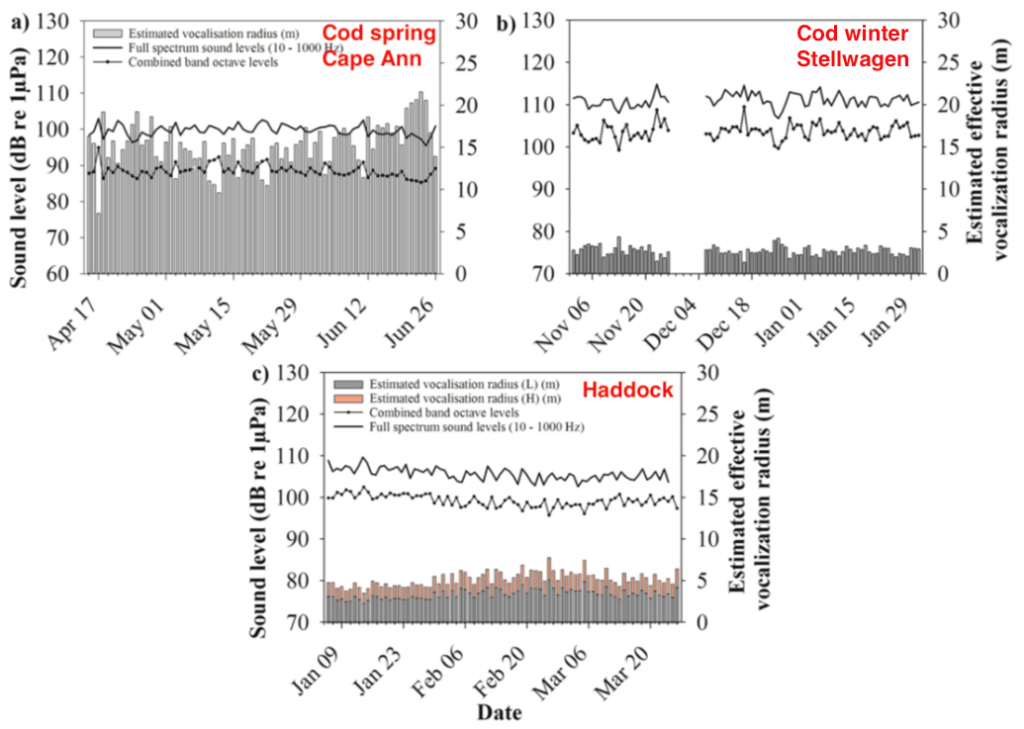More evidence of fish being affected by shipping, energy development noise
Ocean, Ocean energy, Shipping Add commentsA couple of recent studies have added to the increasing evidence that anthropogenic ocean noise can have deleterious effects on fish. As the years go by, it’s becoming clear that it’s not just whales and dolphins that are struggling with human noise in the sea.
A lab-based study of European sea bass found that recordings of pile driving sounds (often associated with bridge, port, or wind farm construction) and of drilling sounds triggered subtle yet troubling changes in behavior. The sudden bursts of pile driving induced a startle response, while both kinds of sounds increased stress, as measured by the fishes’ respiration rate. In addition, both sources of human noise appeared to suppress their normal predator inspection behavior, which could make them more susceptible to predation (though after a half hour of drilling noise, the bass returned to normal anti-predator behavior).
Ilaria Spiga, a doctoral candidate at Newcastle University and the lead author of the study, explained, “Exposure to underwater noises can make it harder for fishes to detect and react to predators. . . If fishes actively avoid areas where these sounds are present it could prevent them from entering spawning grounds, or affect communication between individuals.”
The question of communication was at the heart of a new study from the same team that has been investigating how shipping noise can reduce the communication space of whales. The new research, led by Jenni Stanley, focuses on two key commercial fish, cod and haddock. Utilizing the network of bottom-mounted hydrophones that they’ve deployed in Massachusetts Bay for the past decade, the researchers recorded the grunts of cod and the “knocks” of haddock, along with the noise of ships in the area. The most striking effect was the difference in noise levels between the cod’s winter spawning site near the Boston shipping lanes and their spring spawning site near the fishing fleets of Cape Ann, north of Boston. While there were many more boats near the spring site, these smaller vessels resulted in overall sound levels 11-15dB lower than at the winter site, which in turn allowed the cod to maintain dramatically larger communication space. (The distances over which cod could be heard were not measured directly, but rather calculated based on the source levels of their grunts and the prevailing levels of ship noise.)
At the quieter spring sites, the mean communication distance was 15 meters (below 11m during the noisiest 10% of the time, and over 19m at the quietest 10% of times), while in the winter sites, they could only be heard out to 2.7 meters (with 10% extremes of under 2.1m and over 3.4m at the very best of times). The haddock spawning sites had intermediate noise levels, and at their loudest could be heard at slightly longer range than the winter cod, though a weaker form of their call had the shortest range of any of those assessed.

The authors note (see full paper here):
Mounting evidence suggests that acoustic communication can affect the survival and reproductive success of fishes, including direct evidence for Atlantic cod. . . .Unlike haddock who have a wide acoustic repertoire, Atlantic cod are thought to be less versatile vocalists during courtship. . . If anthropogenic sound reduces the efficiency of the vocalizations utilized by these species, this interference could potentially impact their reproductive success and survival through the incorrect assessment of the quality of potential mates or competitors, reduction in the ability to attract mates and/or the mistiming of gamete release.
While stressing that we still have much to learn about how fish may compensate for noise (by using other cues to find each other, vocalizing during quieter moments, increasing the intensity of their sounds, etc.), the authors conclude:
This research highlights the need to gain a better understanding of the spatial and temporal use of unique habitats that are predictably used for critical life history events in declining populations. Identifying and better understanding these consequences [at all levels of the food chain] is important to advancing the management of shared acoustic space.
